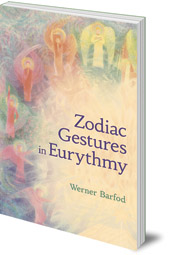Quick Look
- Explores the zodiac gestures in eurythmy, their significance and deeper meaning
- Draws a parallel between meditative exercises and eurythmy practice
- For teachers and practitioners who want to deepen their art and personal spirituial insight
This book shows how zodiac gestures can help eurythmists draw a deeper connection between the earth and the cosmos, unlocking the secrets of the zodiac.
Description
Eurythmy is an art form that makes sounds visible. By incorporating zodiac gestures into their art, as indicated by Rudolf Steiner, eurythmists can draw on a deep connection between the earth and the cosmos.
The zodiac, as representative of the whole cosmos, is a vital part of human spirituality, acting as the backdrop to human life. But it can be hard to fathom the zodiac's secrets, even through meditation. Barfod draws a parallel between meditative exercises and eurythmy practice, and shows how zodiac gestures in eurythmy can reveal cosmic insights.
This is a book for eurythmy teachers and practitioners who want to deepen their art and spiritual work.
Table of Contents
Foreword by Virginia Sease
Preface
Out of the Creative Chaos
1. The Zodiac in Eurythmy
The cosmic human being in the zodiac
The gestures of the day and night colours
The origin of the archetypal colour gestures
The artistic elements and the colour zodiac gestures
Archetypal straight line and spiral tendencies in the zodiac
Forming the zodiac gestures out of colour, the part of the body and the spiral or linear force
The eurythmic characteristics of the zodiac
2. The Consonants in the Zodiac
The consonants as an echo of the cosmic formative forces
The six single and the six double sounds
The essence of the sound as a complete entity
Aries and the sound V
Taurus and the sound R
Gemini and the sound H
Cancer and the sound F
Leo and the sound T
Virgo and sounds B and P
Libra and the sounds C (Ts) and Ch
Scorpio and the sound S
Sagittarius and the sounds G and K
Capricorn and the sound L
Aquarius and the sound M
Pisces and the sound N
3. The Composition of the Totality of the Zodiac
The three crosses of the zodiac
The six axes and their polarities
The trines of the four elements in the zodiac
The post-Atlantean sequence of cultural epochs
The threefold human being within the zodiac
4. Forces of Order in the Sounds of the Zodiac
The sequence of consonants
The evolutionary sequence in the zodiac
The eurythmy figures
The spatial experience of form in the sounds of speech
5. Rudolf Steiner’s Twelve Moods
The twelve zodiac verses
The three verbal moods
Special features of a eurythmy performance
The sequence of planets within the zodiac verse
6. The Zodiac as the Source of All Created Things
Insights into the zodiac given by Rudolf Steiner
The effects of the zodiac on the forming of human beings
The twelve senses in the zodiac
7. Work-Based Movement and Sound in the Zodiac
Introduction to the next three chapters
Traditional work-based movements and sounds
Work and movement – music and speech
The human being in movement and eurythmy
Human work in relation to the course of the year
8. The Zodiac and Technology
Twelve styles of technology
The one-sidedness of the zodiac animals as formative forces
9. Conversational Gestures and the Zodiac
The six speech gestures
Conversational gestures as an imitation of the speech gestures
The conversational gestures in the zodiac
The speech gestures and the colours
Dynamic variety in connection with the speech gestures
Overview and concluding remarks
10. The Connection of Artistic Practice and Training
Introduction
Meditation exercises and the zodiac in eurythmy
The path of knowledge and the zodiac in eurythmy
The shaping of gestures and the path of practice
11. Artistic Elements in Eurythmy and Their Twelve Metamorphoses
12. The Task of the Earthly and the Cosmic Human Being
Wonder, empathy and conscience and the meditations IAO and TAO
Notes
Bibliography
Index
Reviews
'An absolute treasure-trove of information on the Zodiac... I would thoroughly recommend this book to anyone and consider it an absolute must-have for any eurythmist.'
-- The Eurythmy Association of Great Britain and Ireland
Author
Werner Barfod was born in Kiel, Germany in 1936. He studied eurythmy at the Goetheanum in Switzerland with Lea von der Pals, and from 1969 to 2000 was the Director of the Eurythmy Academy in the Hague, and of the Netherlands Eurythmy Ensemble, after which he was the leader of the Performing Arts section of the Goetheanum for seven years.
Sally Lake-Edwards is a eurythmist who has taught in various Steiner-Waldorf schools and centres for adults with special needs in England.
Dr Virginia Sease was born in Pennsylvania and earned her doctorate in German from the University of Southern California. She taught in a university and a Waldorf school in Los Angeles and served as a member of the Executive Council of the Anthroposophical Society at the Goetheanum from 1984 until her retirement in 2015.

